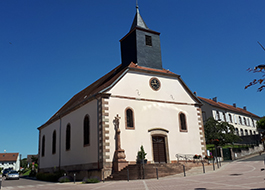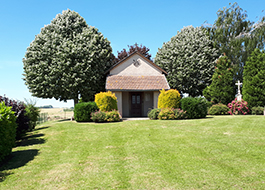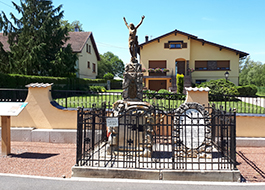Buhl-Lorraine
Durée visite : 30 minutes
Moyen : Pédestre
Cette commune de 1200 habitants est située sur le parcours du canal de la Marne au Rhin. Son nom provient du germanique qui signifie colline. Pour la distinguer de son homonyme alsacienne, le nom de la Lorraine lui a été ajouté. Son histoire est fortement liée à sa voisine sarrebourgeoise.
This town of 1200 inhabitants is located on the route of the Marne-Rhine canal. Its name comes from the Germanic which means hill. To distinguish it from its Alsatian namesake, the name of Lorraine was added to it. Its history is strongly linked to its neighboring Sarrebourg.
Diese Stadt mit 1200 Einwohnern liegt an der Route des Marne-Rhein-Kanals. Sein Name kommt aus dem Germanischen und bedeutet Hügel. Um es von seinem elsässischen Namensvetter zu unterscheiden, wurde ihm der Name Lothringen hinzugefügt. Seine Geschichte ist eng mit dem benachbarten Sarrebourg verbunden.

De gueules au mont de trois coupeaux d’or soutenant un alérion d’argent.
Armes parlantes : la colline (buhl) et l’alérion de Lorraine.
Gules a mount of three cups Or supporting an alerion Argent.
Talking weapons: the hill (buhl) and the alerion of Lorraine.
Gules einen Berg mit drei Bechern oder einen Alerion Argent.
Sprechende Waffen: der Hügel (Buhl) und das Alerion von Lothringen.

Les habitants et les habitantes de Buhl-Lorraine s’appellent les Buhlois et les Buhloises
The inhabitants of Buhl-Lorraine are called Buhlois and Buhloises.
Die Einwohner von Buhl-Lothringen heißen Buhlois und Buhloises.

Les grenouilles
C’est un terme méprisant pour rappeler l’occupation de la partie indigente du village qui cherchait dans les prés humides du ban des batraciens destinés à la vente.
Réf. Dusanus, Volkshumor
Frogs
It is a contemptuous term to recall the occupation of the indigent part of the village which sought in the wet meadows of the ban of batrachians intended for sale.
Ref. Dusanus, Volkshumor
Frösche
Es ist ein verächtlicher Begriff, um an die Besetzung des ärmlichen Teils des Dorfes zu erinnern, die in den feuchten Wiesen des Verbots die zum Verkauf bestimmten Batrachier suchten.
Ref. Dusanus, Volkshumor
Les points de visites
.
L’église saint Gall date de 1743. Elle abrite, chose rare, trois autels en stuc du XVIIIe siècle. Saint Gall vécut au VIIe siècle. Il fut un compagnon de saint Colomban, irlandais comme lui. Avec celui-ci, il fonda l’abbaye de Luxeuil, lors de l’évangélisation du nord-est de la Gaule. Seul, il partit pour le lac de Constance. Là, s’éleva un monastère puis la ville suisse qui porte son nom, Saint Gall.
Dicton : Quand de Saint-Gall arrive l’heure, la vache à l’étable demeure.
The church of Saint Gall dates from 1743. It houses, a rare thing, three stucco altars from the 18th century. Saint Gall lived in the 7th century. He was a companion of Saint Columban, Irish like him. With this one, he founded the abbey of Luxeuil, during the evangelization of the north-east of Gaul. Alone, he left for Lake Constance. There, rose a monastery then the Swiss city which bears its name, Saint Gall.
Saying: When St. Gallen comes the hour, the cow in the stable remains.
Die Kirche St. Gallen stammt aus dem Jahr 1743. Sie beherbergt als Seltenheit drei Stuckaltäre aus dem 18. Jahrhundert. St. Gallen lebte im 7. Jahrhundert. Er war ein Gefährte von Saint Columban, ein Ire wie er. Mit diesem gründete er während der Evangelisierung des Nordostens Galliens die Abtei von Luxeuil. Allein reiste er an den Bodensee. Dort entstand ein Kloster, dann die Schweizer Stadt, die ihren Namen trägt, St. Gallen.
Sprichwort: Wenn St. Gallen die Stunde schlägt, bleibt die Kuh im Stall.
.
.
La chapelle Saint-Pierre et Saint-Paul est construite entre 1859 et 1875. Une première chapelle, érigée en 1690 à l’emplacement de l’ancien village de Weltring, disparut lors de la Révolution française. Des panneaux didactiques vous renseignent sur la géologie locale d’une part, et de l’autre sur la bataille de Sarrebourg d’août 1914. Une plaque rappelle que 130 français sont morts ici, ce jour-là.
The chapel of Saint-Pierre and Saint-Paul was built between 1859 and 1875. A first chapel, erected in 1690 on the site of the old village of Weltring, disappeared during the French Revolution. Didactic panels inform you about the local geology on the one hand, and on the other about the Battle of Sarrebourg in August 1914. A plaque recalls that 130 French people died here, on August 20, 1914.
Die Kapelle Saint-Pierre und Saint-Paul wurde zwischen 1859 und 1875 erbaut. Eine erste Kapelle, die 1690 auf dem Gelände des ehemaligen Dorfes Weltring errichtet wurde, verschwand während der Französischen Revolution. Lehrtafeln informieren einerseits über die lokale Geologie und andererseits über die Schlacht bei Sarrebourg im August 1914. Eine Tafel erinnert daran, dass hier am 20. August 1914 130 Franzosen starben.
.
Le 20 août 1914, un obus a emporté la croix en pierre sur laquelle était fixé un Christ en fonte. Seul celui-ci a subsisté, les bras tendus vers le ciel, retenu à son socle par les pieds. Des photos de cet événement, jugé miraculeux, furent répandues sous forme de milliers de cartes postales, et ce dans le monde entier.
On August 20, 1914, a shell took away the stone cross on which a cast iron Christ was fixed. Only this one has survived, arms outstretched towards the sky, held to its base by its feet. Photos of this event, considered miraculous, were distributed in the form of thousands of postcards, all over the world.
Am 20. August 1914 nahm eine Granate das Steinkreuz mit, auf dem ein gusseiserner Christus befestigt war. Nur dieser hier hat überlebt, die Arme gen Himmel gestreckt, mit den Füßen am Sockel festgehalten. Fotos dieses als Wunder geltenden Ereignisses wurden in Form von Tausenden von Postkarten auf der ganzen Welt verteilt.








